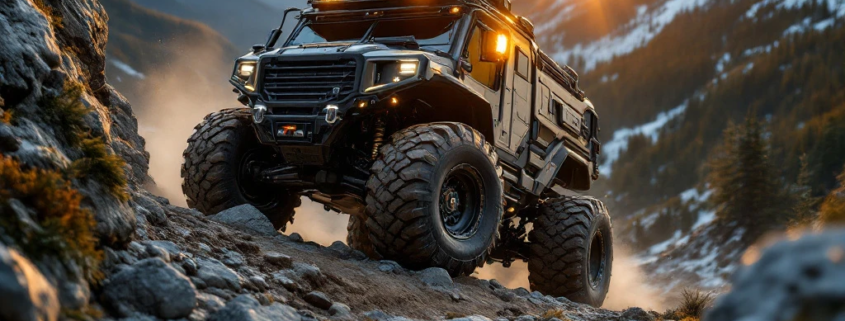How Do Off-Highway Vehicles Maintain Performance in Rugged Terrains?
Specialized design features and rugged engineering enable off-road machinery to excel in challenging landscapes. Advanced suspension systems absorb shocks while maintaining stability, and specially-designed powertrains distribute torque where needed for optimal traction. Reinforced components withstand constant battering from rocks and debris, while sophisticated terrain management systems continuously monitor conditions to make real-time adjustments. Regular maintenance schedules tailored for extreme conditions ensure these vehicles maintain peak performance throughout their operational lifetime.
How do off-highway vehicles maintain performance in rugged terrains?
Off-highway vehicles face constant challenges that standard road vehicles rarely encounter. Extreme inclines, loose surfaces, mud, rocks, and widely varying weather conditions all demand specialized technological solutions. These robust machines rely on integrated systems that work together to maintain stability, traction, and operational efficiency.
At the core of terrain performance are several critical vehicle systems that must be engineered specifically for harsh conditions. Advanced suspension configurations, specialized powertrains, reinforced chassis components, and intelligent control systems form the backbone of capability. For industrial applications, consistent performance across challenging environments directly impacts operational efficiency and project timelines.
Modern off-highway vehicles increasingly incorporate intelligent systems that can monitor terrain conditions and adjust vehicle parameters accordingly. CAN-bus technology and integrated digital control systems allow for precise adjustments to engine output, suspension settings, and power distribution based on real-time feedback from multiple vehicle sensors.
What suspension systems are best for off-highway vehicle performance?
The ideal suspension system for off-highway applications varies based on vehicle purpose, but hydraulic systems generally offer superior performance in the most demanding environments. These systems provide excellent adaptability to changing terrain conditions through variable damping rates and ride height adjustments, effectively absorbing significant impacts while maintaining operational stability.
Hydraulic suspension systems excel in heavy-duty applications because they can handle extreme loads while providing necessary articulation. The pressure in each hydraulic cylinder can be independently controlled, allowing for adaptive response to terrain variations. When one wheel encounters an obstacle, the system can adjust pressure distribution to maintain maximum ground contact across all wheels.
Air suspension systems offer compelling advantages in certain applications, particularly where ride comfort must be balanced with performance. These systems can rapidly adjust to changing loads and provide excellent vibration isolation. However, they typically require more complex control systems and may be more vulnerable to damage in extremely harsh environments.
Mechanical suspension designs, including leaf springs, coil springs, and torsion bars, continue to play important roles in many off-highway applications. Their simplicity offers reliability advantages, though they typically cannot match the adaptability of hydraulic or air systems. Many modern vehicles employ hybrid approaches, combining mechanical components with hydraulic or electronic damping control.
How do engine and powertrain systems adapt to challenging environments?
Engine and powertrain configurations for off-highway vehicles typically feature enhanced cooling systems capable of maintaining optimal operating temperatures under extreme loads. These robust designs often incorporate oversized radiators, auxiliary cooling circuits, and strategic airflow management to prevent overheating during sustained high-torque operations.
Torque distribution represents a critical factor in maintaining traction across variable surfaces. Advanced differentials, including limited-slip and locking designs, prevent power loss when individual wheels lose ground contact. Modern vehicles frequently employ electronic control systems that can instantly detect wheel slip and redirect power to wheels with better traction.
Intelligent power management systems continuously monitor multiple parameters including engine load, wheel speed, traction conditions, and incline angle. These systems, often built on advanced CAN-bus architecture, make millisecond adjustments to throttle response, transmission settings, and differential behavior based on terrain feedback.
Environmental protection features help engines perform reliably in dusty, wet, or extreme temperature conditions. Enhanced air filtration systems, sealed electrical components, and specialized lubricants protect vital systems from contamination. Cold-weather packages may include block heaters and fuel conditioning systems, while hot-weather configurations focus on preventing vapor lock and optimizing cooling efficiency.
What maintenance practices ensure optimal off-highway vehicle performance?
Regular preventative maintenance forms the cornerstone of reliable off-highway vehicle performance. Maintenance intervals should be adjusted based on operational conditions, with more frequent service required for vehicles operating in particularly harsh environments. Consistent documentation of maintenance activities helps identify recurring issues before they cause critical failures.
Component inspection should focus on high-stress areas and items subject to accelerated wear in rugged conditions. This includes suspension mounting points, drivetrain connections, undercarriage components, and hydraulic systems. Detailed visual inspections can often reveal early warning signs of potential failures, including unusual wear patterns, fluid leaks, or structural deformation.
Fluid analysis provides valuable insight into internal component health. Regular sampling and testing of engine oil, transmission fluid, hydraulic fluid, and coolant can identify contaminants and wear metals before they cause catastrophic failures. Trend analysis of these results helps predict maintenance needs and optimize service intervals.
Environmental factors significantly impact maintenance requirements. Vehicles operating in dusty conditions require more frequent air filter replacement and cleaning of cooling system components. Those working in wet or corrosive environments benefit from additional undercarriage cleaning and protective treatments. Cold weather operation demands special attention to battery condition, fuel quality, and hydraulic system performance.
Digital diagnostic tools have revolutionized maintenance practices for modern off-highway vehicles. Systems built on CAN-bus technology enable technicians to quickly identify issues through error codes and performance data. Predictive maintenance algorithms can analyze operational patterns to forecast component failures before they occur, reducing costly downtime.
By implementing comprehensive maintenance protocols specifically designed for the operational environment, fleet managers can significantly extend vehicle life while maintaining peak performance capabilities across even the most challenging terrains.
See how technology powers performance off the beaten path.
Our off-highway case studies reveal how advanced control systems and CAN communication optimize operations in demanding terrain and conditions.



